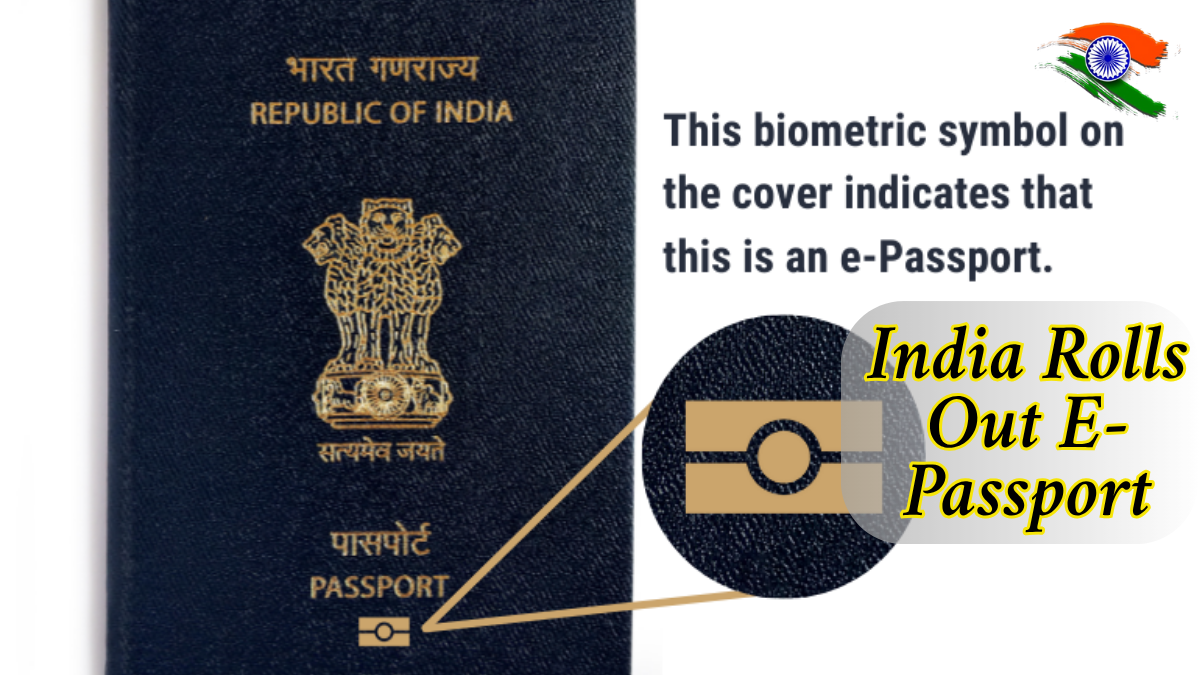India has taken a significant step toward digitizing travel documentation with the introduction of the e-passport. Launched under the Passport Seva Programme (PSP) Version 2.0 on April 1, 2024, this initiative is part of a larger effort by the Ministry of External Affairs (MEA) to modernize the passport issuance and verification process while increasing security and convenience for Indian citizens.

Quick Summary of Indian E-Passport 2025
| Feature | Details |
|---|---|
| Launch Date | April 1, 2024 |
| Launched By | Ministry of External Affairs, Government of India |
| Technology Used | RFID Chip with Biometric and Personal Data Storage |
| Identification Symbol | Gold-coloured chip symbol on the front cover |
| Key Cities with E-Passport | Nagpur, Bhubaneswar, Jammu, Goa, Shimla, Raipur, Amritsar, etc. |
| Existing Passport Replacement | Not mandatory for current passport holders |
| Official Website | passportindia.gov.in |
What is an Indian E-Passport?
An Indian e-passport is a secure travel document that integrates traditional paper-based data with an electronic chip embedded in the back cover. This chip uses Radio Frequency Identification (RFID) technology and stores biometric and personal information of the passport holder. It is digitally signed to ensure authenticity and prevent tampering.
The integration of electronic features allows for faster, more secure processing at immigration checkpoints, both in India and abroad. The e-passport is a part of India’s broader digitization goals and aligns with international standards set by the International Civil Aviation Organization (ICAO).
How to Identify an E-Passport?
An e-passport looks similar to a regular passport but includes a gold-coloured symbol printed below the word “Passport” on the front cover. This symbol represents the embedded RFID chip.
Key Features of the Indian E-Passport
- Biometric Security: Contains biometric data like fingerprints and facial recognition.
- Digitally Signed Chip: Enhances protection against forgery and unauthorized data access.
- International Compatibility: Recognized globally for seamless travel.
- Tamper-Proof Design: Makes duplication or manipulation of passport details extremely difficult.
- Efficient Immigration Clearance: Eases identity verification process at airports.
Benefits of an E-Passport
- Data Integrity: The digitally signed chip ensures that data cannot be altered without detection.
- Fraud Prevention: Reduces chances of fake or duplicate passports.
- Global Authentication: Allows immigration officials worldwide to authenticate identity quickly.
- Faster Processing: Simplifies and speeds up security checks at airports.
- Durability: Higher durability compared to conventional passports due to advanced materials.
Data Storage and Security
The data on an e-passport is protected using Public Key Infrastructure (PKI). PKI ensures that sensitive personal and biometric data stored on the RFID chip is secure and can be read only by authorized systems. This encryption protocol is globally accepted for data integrity and authentication.
Where Are E-Passports Issued?
As of now, e-passports are available at selected regional passport offices, including:
- Nagpur
- Bhubaneswar
- Jammu
- Goa
- Shimla
- Raipur
- Amritsar
- Jaipur
- Chennai
- Hyderabad
- Surat
- Ranchi
The government is working on scaling the issuance of e-passports to more cities in the near future.
Do You Need to Replace Your Current Passport?
No, holders of currently valid passports are not required to replace them with an e-passport. Their passports will remain valid until the expiration date. However, applicants for a new passport or passport renewal can choose to apply for an e-passport, where available.
How to Apply for an E-Passport in India
- Visit the Official Portal: Go to passportindia.gov.in.
- Login or Register: Create an account or log in.
- Fill Application Form: Choose the passport type as ‘e-passport’ (if available in your region).
- Submit Documents: Upload scanned copies of required documents.
- Schedule Appointment: Book a slot at your nearest Passport Seva Kendra or Regional Passport Office.
- Attend Appointment: Visit the centre with original documents and complete biometric verification.
- Track Status: Use your application number to track the status online.
Future of E-Passports in India
The Indian government plans to gradually expand the issuance of e-passports to all citizens. Over time, e-passports will replace traditional booklets entirely, aligning India with global best practices and improving international travel infrastructure.
The success of the pilot launch in 2024 is expected to influence the national rollout across all states.
Frequently Asked Questions (FAQs)
Q1. When was the Indian e-passport launched?
A: The Indian e-passport was launched on April 1, 2024, under the Passport Seva Programme 2.0.
Q2. Is an e-passport mandatory for all Indian citizens?
A: No, existing passports remain valid until expiry. E-passports are currently optional.
Q3. How do I know if my passport is an e-passport?
A: Look for a gold chip symbol on the front cover of the passport.
Q4. Are e-passports secure?
A: Yes, they use RFID technology and PKI encryption to protect stored biometric and personal data.
Q5. Can I get an e-passport in any city?
A: Currently, e-passports are available at selected regional offices, but more centres will offer them soon.
Q6. Are digitally signed scorecards or e-documents legally valid?
A: Yes, documents issued through DigiLocker or government portals are recognized for official use.
For more details, visit the official passport website: passportindia.gov.in.
For More Information Click Here
